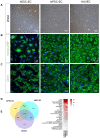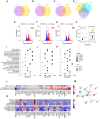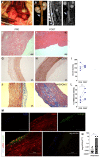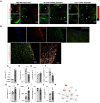3D culturing of human pluripotent stem cells-derived endothelial cells for vascular regeneration
- PMID: 35832092
- PMCID: PMC9254250
- DOI: 10.7150/thno.69938
3D culturing of human pluripotent stem cells-derived endothelial cells for vascular regeneration
Abstract
Rationale: Human induced pluripotent stem cell-derived endothelial cells can be candidates for engineering therapeutic vascular grafts. Methods: Here, we studied the role of three-dimensional culture on their characteristics and function both in vitro and in vivo. Results: We found that differentiated hPSC-EC can re-populate decellularized biomatrices; they remain viable, undergo maturation and arterial/venous specification. Human PSC-EC develop antifibrotic, vasoactive and anti-inflammatory properties during recellularization. In vivo, a robust increase in perfusion was detected at the engraftment sites after subcutaneous implantation of an hPSC-EC-laden hydrogel in rats. Histology confirmed survival and formation of capillary-like structures, suggesting the incorporation of hPSC-EC into host microvasculature. In a canine model, hiPSC-EC-seeded onto decellularised vascular segments were functional as aortic grafts. Similarly, we showed the retention and maturation of hiPSC-EC and dynamic remodelling of the vessel wall with good maintenance of vascular patency. Conclusions: A combination of hPSC-EC and biomatrices may be a promising approach to repair ischemic tissues.
Keywords: angiogenesis tracking; endothelial cells; human pluripotent stem cells; multimodality imaging; tissue-engineered vascular grafts.
© The author(s).
Conflict of interest statement
Competing Interests: DM is managing director, CROmed Research Ltd, grant-in-aid of Mediso Ltd. by providing nanoScan PET-MRI instrument usage time.
Figures







Similar articles
-
Enhanced Therapeutic and Long-Term Dynamic Vascularization Effects of Human Pluripotent Stem Cell-Derived Endothelial Cells Encapsulated in a Nanomatrix Gel.Circulation. 2017 Nov 14;136(20):1939-1954. doi: 10.1161/CIRCULATIONAHA.116.026329. Epub 2017 Sep 29. Circulation. 2017. PMID: 28972000 Free PMC article.
-
Sphingosine-1-phosphate in Endothelial Cell Recellularization Improves Patency and Endothelialization of Decellularized Vascular Grafts In Vivo.Int J Mol Sci. 2019 Apr 2;20(7):1641. doi: 10.3390/ijms20071641. Int J Mol Sci. 2019. PMID: 30987025 Free PMC article.
-
Bio-engineering a tissue flap utilizing a porous scaffold incorporating a human induced pluripotent stem cell-derived endothelial cell capillary network connected to a vascular pedicle.Acta Biomater. 2019 Aug;94:281-294. doi: 10.1016/j.actbio.2019.05.067. Epub 2019 May 30. Acta Biomater. 2019. PMID: 31152943
-
Small-Caliber Tissue-Engineered Vascular Grafts Based on Human-Induced Pluripotent Stem Cells: Progress and Challenges.Tissue Eng Part B Rev. 2023 Aug;29(4):441-455. doi: 10.1089/ten.TEB.2023.0005. Epub 2023 Apr 12. Tissue Eng Part B Rev. 2023. PMID: 36884294 Review.
-
Concise review: tissue-specific microvascular endothelial cells derived from human pluripotent stem cells.Stem Cells. 2014 Dec;32(12):3037-45. doi: 10.1002/stem.1797. Stem Cells. 2014. PMID: 25070152 Free PMC article. Review.
Cited by
-
Human Pluripotent Stem Cell-Derived Endothelial Cells in Disease Modeling and Drug Screening.Methods Mol Biol. 2025;2924:113-130. doi: 10.1007/978-1-0716-4530-7_9. Methods Mol Biol. 2025. PMID: 40307639
-
Injectable hypoxia-preconditioned cartilage progenitor cells-laden GelMA microspheres system for enhanced osteoarthritis treatment.Mater Today Bio. 2023 Apr 17;20:100637. doi: 10.1016/j.mtbio.2023.100637. eCollection 2023 Jun. Mater Today Bio. 2023. PMID: 37128287 Free PMC article.
References
-
- World Health Organization. Global status report on noncommunicable diseases 2014, in 2015. - PubMed
-
- Slovut DP, Lipsitz EC. Surgical technique and peripheral artery disease. Circulation. 2012;126:1127–38. - PubMed
-
- Isenberg BC, Williams C, Tranquillo RT. Small-diameter artificial arteries engineered in vitro. Circ Res. 2006;98:25–35. - PubMed
-
- Seifu DG, Purnama A, Mequanint K, Mantovani D. Small-diameter vascular tissue engineering. Nat Rev Cardiol. 2013;10:410–21. - PubMed
Publication types
MeSH terms
Grants and funding
LinkOut - more resources
Full Text Sources

